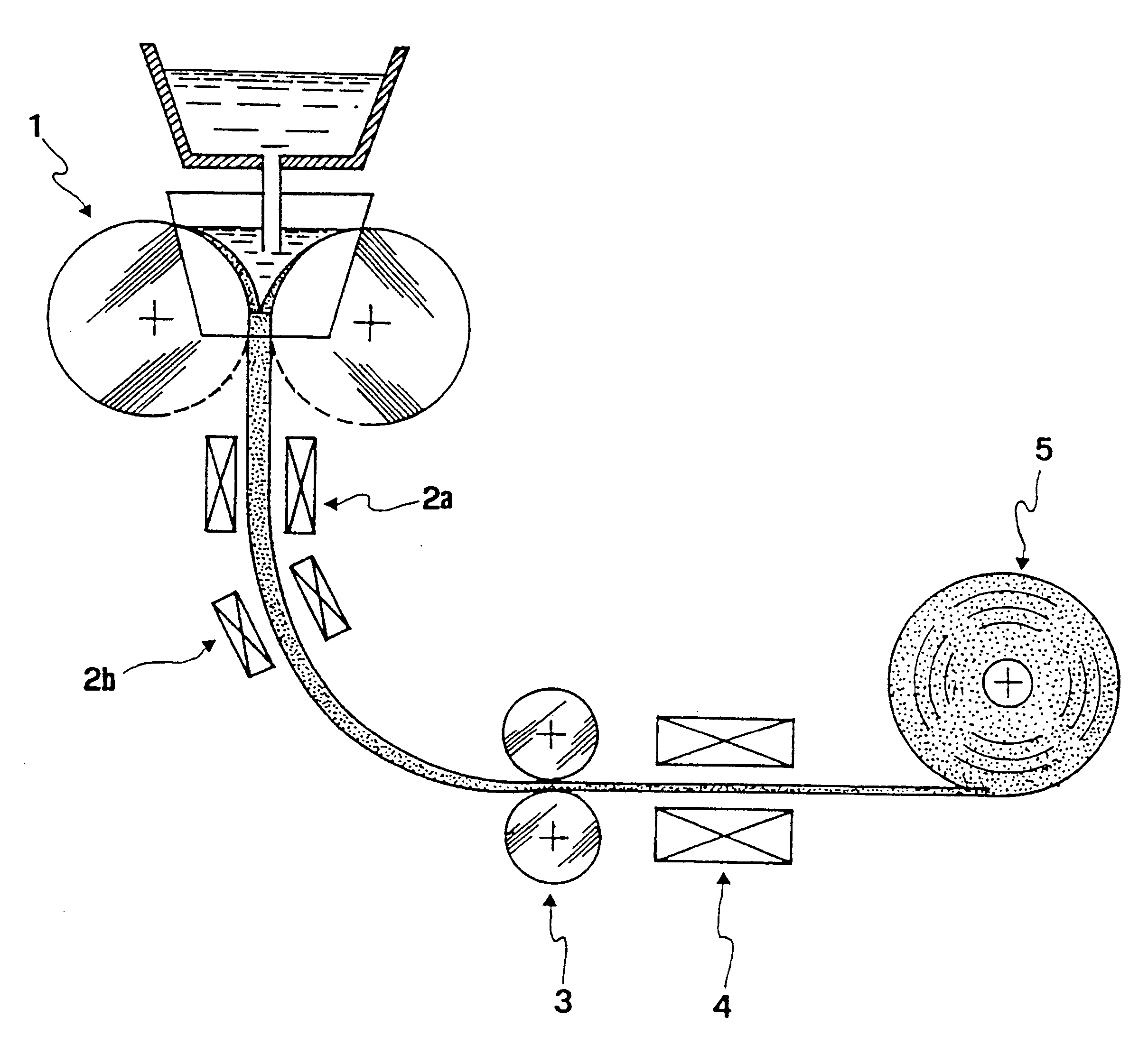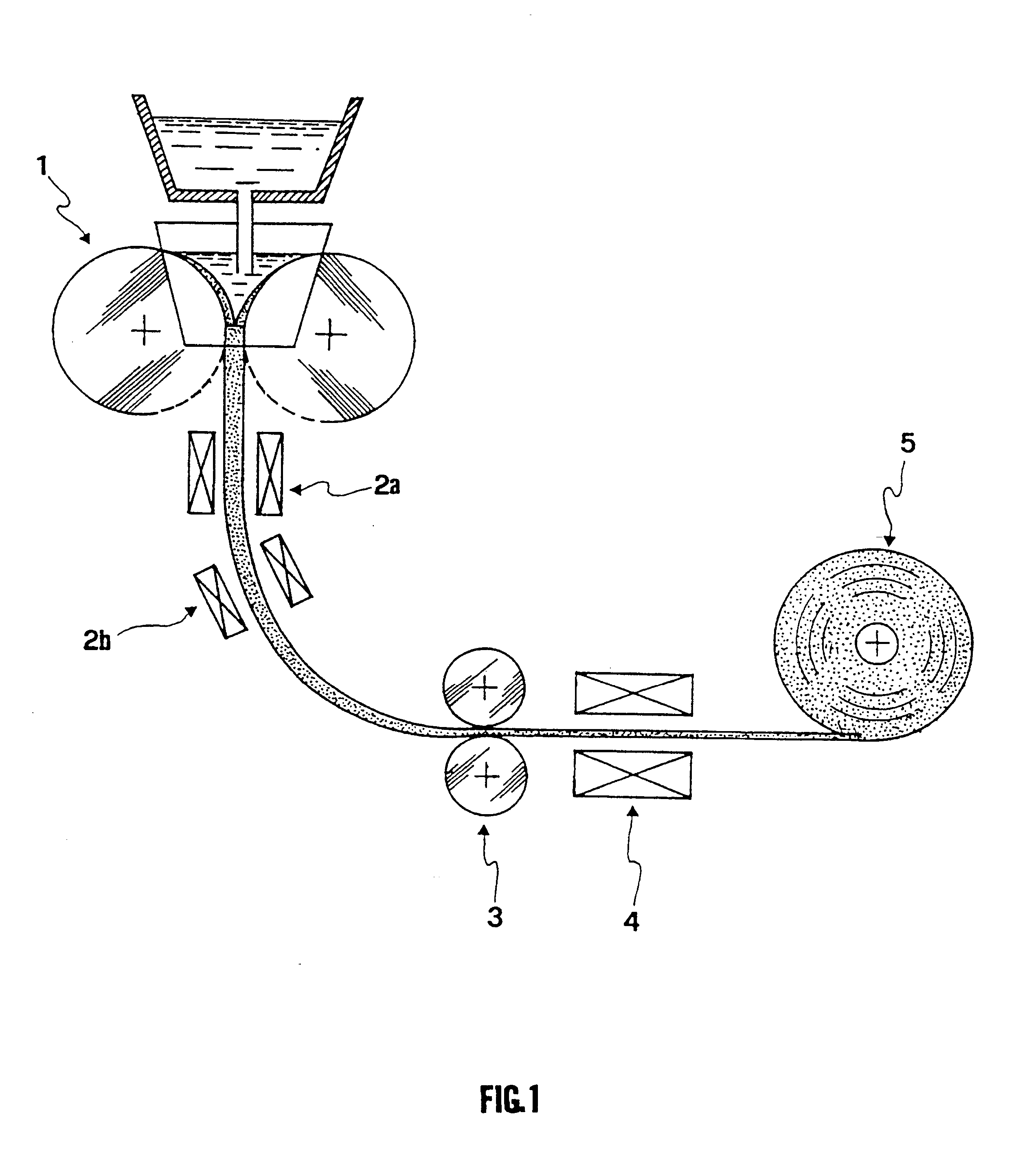Continuous casting process for producing low carbon steel strips and strips so obtainable with good as cast mechanical properties
a casting process and low carbon steel technology, applied in the field of low carbon steel strip production, can solve the problems of less unity of the whole installation from the casting machine to the coiling reel, higher energy consumption, and further installations, and achieve good weldability and strength. good combination of ductility
- Summary
- Abstract
- Description
- Claims
- Application Information
AI Technical Summary
Benefits of technology
Problems solved by technology
Method used
Image
Examples
example 2
Other strips having a thickness of 2.0-2.5 mm were obtained with the process of the present invention, by using the B and C types of steel of table 1, having a higher carbon content (0.052% and 0.09%, respectively).
The main cooling and coiling conditions are shown in table 4, together with some microstructure features of the strips so obtained. The mechanical properties of the strips and the Erichsen index, measure of the cold formability of the materials, are reported in table 5.
In FIGS. 7 and 8 the typical microstructures respectively of the strips 7 (steel B) and 14 (steel C), as observed through an optical microscope, are shown. Also in this case, by exploiting the phase transformation features of the coarse austenitic grain steels, it is possible to obtain mixed structures containing equiaxed ferrite and also acicular ferrite and bainite. The strength values are higher than those shown in example 1, relating to steel having 0.035% C, and ductility and cold formability remain at...
example 3
In this comparative example, the microstructures and the mechanical properties of a strip having a thickness of 2 mm and obtained with the steel of the D type (table 1) produced with a traditional cycle and comparing with those of a strip as cast, having the same chemical analysis, produced according to the process of the present invention, are reported. Clearly, the microstructure of the traditional strip is constituted by thin grains of polygonal ferrite and by perlite (FIG. 9), with a tensile stress diagram of a discontinuous pattern (FIG. 10). The typical mechanical properties of this conventional strip are shown in table 6. The use of relatively low coiling temperatures (table 7), with the process of the present invention allows the use of materials with acicular structures of the type as shown in FIG. 11, which are characterized by similar values of fracture stress, with a continuous pattern yield diagram (FIG. 12), and therefore with a lower yield / fracture stress ratio (table...
example 4
Some strips obtained according to the process of the present invention and made by the A and B types of steels, were pickled and underwent weldability trials. The point resistance welding trials were performed with electrodes having a diameter of 8 mm, adopting a stress of 650 kg, and by varying the current. In FIGS. 13a and 13b the diagrams that at the "number of cycles-current intensity" level provide weldability lobes, i.e. the field wherein the steel sheets are weldable without problems, are respectively shown. The comparison with a pickled sheet-steel having similar thickness, in low carbon steel obtained by a conventional production cycle (FIG. 14), shows how the strips obtained with the process of the present invention keep good weldability features, as to indicate an acceptable superficial state.
TABLE 2
TABLE 3
TABLE 4
TABLE 5
TABLE 6
TABLE 7
TABLE 8
PUM
| Property | Measurement | Unit |
|---|---|---|
| Temperature | aaaaa | aaaaa |
| Temperature | aaaaa | aaaaa |
| Temperature | aaaaa | aaaaa |
Abstract
Description
Claims
Application Information
 Login to View More
Login to View More - R&D
- Intellectual Property
- Life Sciences
- Materials
- Tech Scout
- Unparalleled Data Quality
- Higher Quality Content
- 60% Fewer Hallucinations
Browse by: Latest US Patents, China's latest patents, Technical Efficacy Thesaurus, Application Domain, Technology Topic, Popular Technical Reports.
© 2025 PatSnap. All rights reserved.Legal|Privacy policy|Modern Slavery Act Transparency Statement|Sitemap|About US| Contact US: help@patsnap.com



